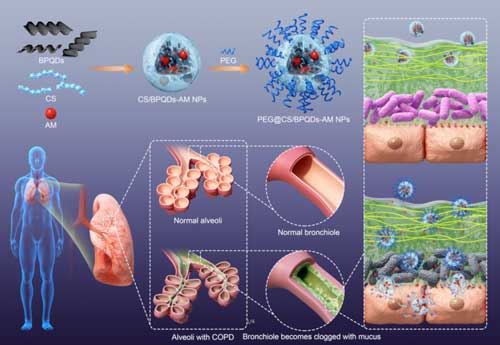| Jul 24, 2020 | |
Mucus-penetrating nanocarriers for efficient therapy of chronic obstructive pulmonary disease(Nanowerk News) Chronic obstructive pulmonary disease (COPD) is a kind of severe chronic inflammatory lung disease which could cause obstructed airflow and even death. According to the forecast of World Health Organization, COPD will rise to the third cause of death worldwide in 2030 |
|
| Due to the mesh-like structure, the sticky mucus layer of COPD patients could hinder the access of the drug to epithelium, like a permeation barrier. Besides, numerous bacterial pathogens in the mucus layer can form a dense biofilm to avoid drug contact and cause multi-drug resistance. | |
| Recently, researchers from the Shenzhen Institutes of Advanced Technology (SIAT) of the Chinese Academy of Sciences and Zhongshan Hospital developed mucus-penetrating nano-carriers to deliver drugs therapeutically for COPD. | |
 |
|
| Schematic diagram illustrating the fabrication process of PEG@CS/BPQDs-AM NPs and biomedical application as a drug delivery system that penetrates pulmonary mucus layer, releases therapeutic agents, and inactivates pathogenic bacteria to alleviate COPD. (Image: LI Zhibin) (click on image to enlarge) | |
| The study was published in Angewandte Chemie International Edition ("Mediated Drug Release from Nano-Vehicles by Black Phosphorus Quantum Dots for Efficient Therapy of Chronic Obstructive Pulmonary Disease"). | |
| The researchers combined PEGylated chitosan nanoparticles and biodegradable black phosphorus quantum dots (BPQDs) to deliver amikacin for efficient therapy of COPD. | |
| In this scenario, the PEGylated chitosan nanoparticles could readily penetrate through the mucus barrier due to the good hydrophilicity of PEG, and adhere onto mucous epitheliumon by the positive charge of chitosan. | |
| The interior BPQDs could be rapidly degraded into nontoxic PO43- and acidic H+, and then promoted the dissociation of PEGylated chitosan nanospheres, accelerated the release of therapeutic amikacin, and eventually debilitated the vitality of biofilms for ease of eradication. | |
| With satisfactory anti-infection effect and good biosafety, this delivery system is promising in COPD therapy, and it provides new design insights and fabrication ideas for other drug delivery systems as well. |
| Source: Chinese Academy of Sciences | |
|
Subscribe to a free copy of one of our daily Nanowerk Newsletter Email Digests with a compilation of all of the day's news. |
